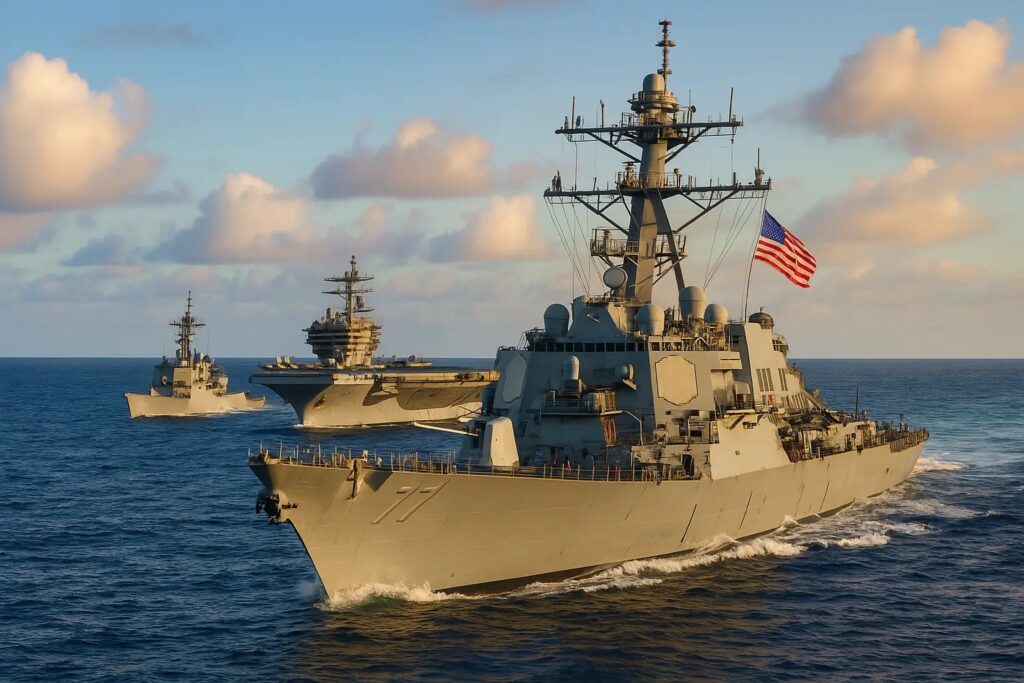US Navy Ships Iron Giants That Guard the Seas
Across vast oceans and strategic chokepoints, silent steel behemoths glide—watchful, powerful, and relentless. These are not just vessels; they are floating fortresses, brimming with cutting-edge technology and unmatched firepower. The US Navy ships form the backbone of American naval supremacy, projecting strength in distant waters and silently influencing global affairs.
This isn’t just a list of ships—it’s a living, breathing armada that stands as a warning to adversaries and a shield for allies.
The Modern Fleet: Built for a Changing World
The modern threats America faces aren’t the same as decades ago—and the Navy has evolved accordingly. Today’s fleet isn’t just about brute strength; it’s about agility, cyber defense, electronic warfare, precision strikes, and deterrence through visibility.
Aircraft Carriers — Floating Cities of War
Let’s begin with the crown jewels—the nuclear-powered aircraft carriers. These are more than just ships; they are mobile airbases capable of launching assaults, supporting allies, or preventing conflict just by their presence.
- Gerald R. Ford-class: The most advanced aircraft carriers ever built. They feature electromagnetic catapults, reduced crew needs, and greater sortie generation. These ships are the future.
- Nimitz-class: Though older, they remain deadly. With over 5,000 personnel aboard, each is a self-contained strike force.
These ships don’t just carry aircraft—they carry America’s global resolve.
Submarines — Silent, Deadly Shadows
Beneath the surface, an invisible game is played. US Navy submarines move silently, unseen and undetected, holding the power to destroy cities or gather secrets from enemy waters.
Ballistic Missile Submarines (SSBNs)
- Known as “boomers”, these vessels are America’s nuclear second-strike guarantee.
- Ohio-class SSBNs can carry up to 24 Trident II nuclear missiles—ready to fire if the homeland is ever attacked.
Attack Submarines (SSNs)
- Virginia-class: Fast, stealthy, and lethal—optimized for intelligence, special ops, and anti-ship warfare.
- Los Angeles-class: Aging but still crucial in America’s undersea dominance.
- Seawolf-class: Rare and expensive, but unparalleled in underwater speed and silence.
These underwater warriors make sure no enemy fleet ever sleeps easy.
Destroyers and Cruisers — Shields of the Fleet
Every carrier needs guardians. That’s where the destroyers and cruisers come in.
Arleigh Burke-class Destroyers
- These are the most numerous surface combatants in the fleet.
- Equipped with the Aegis Combat System, they can shoot down ballistic missiles, intercept aircraft, and neutralize enemy ships.
- Fast, versatile, and everywhere—from the Persian Gulf to the South China Sea.
Ticonderoga-class Cruisers
- Heavily armed with vertical launch systems.
- Aging, but still capable of commanding sea battle groups.
- Set to be replaced, but their role in shaping 21st-century maritime strategy is undeniable.
Littoral Combat Ships — Agile and Experimental
In shallow, tricky coastal waters, massive destroyers are too bulky. That’s where Littoral Combat Ships (LCS) come in.
- Independence-class: Trimaran hulls, futuristic design, and mission-focused modules.
- Freedom-class: Faster, single-hull ships used for anti-submarine and mine countermeasures.
Though controversial for their cost and mechanical reliability, they represent a bold experiment in modular naval warfare.
Amphibious Assault Ships — Bringing the Fight to Shore
When the U.S. decides to put boots on the ground from the sea, amphibious assault ships do the heavy lifting.
- America-class and Wasp-class ships can launch helicopters, tilt-rotors, and even F-35B jets from their decks.
- They carry Marines, landing craft, and armored vehicles to turn coastline into battlefield in hours.
These floating power bases are often the first to arrive in crises—humanitarian or military.
Support and Supply Ships — The Unsung Heroes
No warship can fight long without fuel, food, and ammo. That’s where the Military Sealift Command comes in, managing tankers, hospital ships, and logistics vessels.
- USNS Mercy and USNS Comfort are hospital ships that bring hope during disasters and war.
- Replenishment oilers, dry cargo ships, and high-speed transports keep the frontline units ready for battle.
These ships rarely make headlines but are vital lifelines for the entire fleet.
New Horizons: The Future of US Navy Ships
The sea is changing again—and the Navy is racing ahead.
- Unmanned surface and underwater vehicles are being tested to patrol, scout, and even strike without risking lives.
- DDG(X) will replace older destroyers with futuristic powerplants and advanced weapons.
- The push for hypersonic missiles and railguns could make the next generation of US Navy ships nearly untouchable.
What we see today is just the foundation of a deadlier, smarter, more networked future fleet.
Why It Matters: A Message Etched in Steel
The world watches these ships. They dock in friendly harbors to reassure and in hostile waters to warn. Each one carries more than missiles or sailors—it carries a message:
“Peace, if possible. Power, if necessary.”
The US Navy ships aren’t just war machines—they’re political signals, humanitarian angels, and guardians of international trade routes.
From Arctic patrols to Pacific standoffs, from disaster relief to high-stakes deterrence, these vessels stand ready—powered by sailors, built by a nation, and aimed at peace through strength.
Final Thoughts: A Fleet That Speaks Without Words
In an age where enemies grow bolder and the seas become battlegrounds of influence, the United States Navy doesn’t just float—it commands.
It’s easy to list ships. But behind each name is a mission, a legacy, and a living story of sailors who sacrifice, engineers who innovate, and a country that still believes in keeping the seas free.
The world’s most powerful navy doesn’t sleep. Its ships roam the oceans, watching, waiting, ready.

